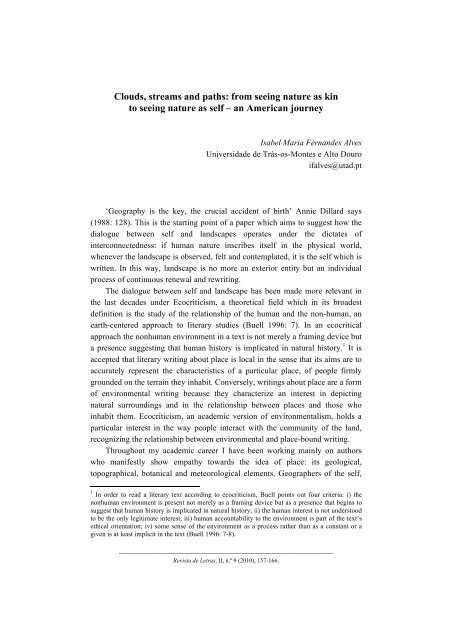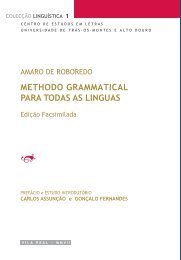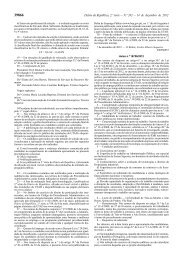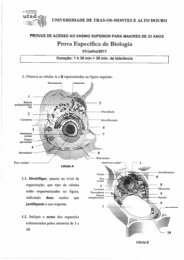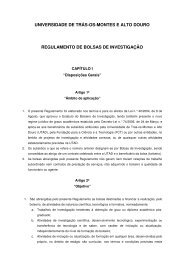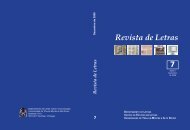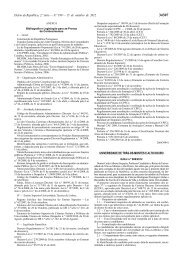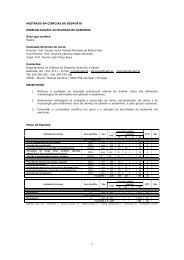- Page 1 and 2:
Dezembro de 2010Revista de LetrasRe
- Page 4:
Cartas do meu rio, Douro, nas comem
- Page 7 and 8:
ÍNDICENota IntrodutóriaCarlos Ass
- Page 9:
Cartas do meu rio, Douro, nas comem
- Page 12 and 13:
8 Nota IntrodutóriaA atenção à
- Page 15:
LINGUÍSTICA
- Page 18 and 19:
14 António Bárbolo Alves, Margari
- Page 20 and 21:
16 António Bárbolo Alves, Margari
- Page 22 and 23:
18 António Bárbolo Alves, Margari
- Page 24:
20 António Bárbolo Alves, Margari
- Page 29 and 30:
Yerbas i árboles de la Tierra de M
- Page 31 and 32:
Yerbas i árboles de la Tierra de M
- Page 33 and 34:
Yerbas i árboles de la Tierra de M
- Page 35 and 36:
Yerbas i árboles de la Tierra de M
- Page 37 and 38:
Yerbas i árboles de la Tierra de M
- Page 39:
Yerbas i árboles de la Tierra de M
- Page 42 and 43:
38 Sónia Coelhoposterioridade, tod
- Page 44 and 45:
40 Sónia Coelhopertence a todos os
- Page 46 and 47:
42 Sónia Coelho2.3. Aumentativos2.
- Page 48 and 49:
44 Sónia CoelhoPara a língua port
- Page 50 and 51:
46 Sónia Coelhoproposições de, o
- Page 52 and 53:
48 Sónia CoelhoSchäfer-Prieß, Ba
- Page 54 and 55:
50 Rui Dias GuimarãesIntroduçãoA
- Page 56 and 57:
52 Rui Dias GuimarãesMapa dos Dial
- Page 58 and 59:
54 Rui Dias GuimarãesNas recolhas
- Page 60 and 61:
56 Rui Dias Guimarãescomo sua esta
- Page 62 and 63:
58 Rui Dias Guimarãesuma serpente
- Page 64 and 65:
60 Rui Dias GuimarãesInfluence on
- Page 67 and 68:
O ideário linguístico no Novo met
- Page 69 and 70:
O ideário linguístico no Novo met
- Page 71 and 72:
O ideário linguístico no Novo met
- Page 73 and 74:
O ideário linguístico no Novo met
- Page 75 and 76:
O ideário linguístico no Novo met
- Page 77 and 78:
O ideário linguístico no Novo met
- Page 79 and 80:
O ideário linguístico no Novo met
- Page 81 and 82:
O ideário linguístico no Novo met
- Page 83 and 84:
O ideário linguístico no Novo met
- Page 85 and 86:
O ideário linguístico no Novo met
- Page 87 and 88:
O ideário linguístico no Novo met
- Page 89 and 90:
O ideário linguístico no Novo met
- Page 91 and 92:
O ideário linguístico no Novo met
- Page 93 and 94:
O ideário linguístico no Novo met
- Page 95 and 96:
O ideário linguístico no Novo met
- Page 97 and 98:
Contributos para a análise da elip
- Page 99 and 100:
Contributos para a análise da elip
- Page 101 and 102:
Contributos para a análise da elip
- Page 103 and 104:
Contributos para a análise da elip
- Page 105 and 106:
Contributos para a análise da elip
- Page 107:
Contributos para a análise da elip
- Page 110 and 111: 106 Maria Olinda Rodrigues Santanae
- Page 112 and 113: 108 Maria Olinda Rodrigues SantanaL
- Page 114 and 115: 110 Maria Olinda Rodrigues SantanaL
- Page 116 and 117: 112 Maria Olinda Rodrigues Santanac
- Page 118 and 119: 114 Maria Olinda Rodrigues Santanaa
- Page 120 and 121: 116 Maria Olinda Rodrigues SantanaS
- Page 122 and 123: 118 Maria Olinda Rodrigues SantanaR
- Page 124 and 125: 120 Maria Olinda Rodrigues SantanaA
- Page 126 and 127: 122 Barbara Schäfer-Prießservem c
- Page 128 and 129: 124 Barbara Schäfer-PrießFinalmen
- Page 130 and 131: 126 Barbara Schäfer-Prieß1.2 A Ar
- Page 132 and 133: 128 Barbara Schäfer-Prießcomprovo
- Page 134 and 135: 130 Barbara Schäfer-Prießa pergun
- Page 136 and 137: 132 Barbara Schäfer-PrießDe manei
- Page 138 and 139: 134 Barbara Schäfer-Prieß[...] qu
- Page 140 and 141: 136 Barbara Schäfer-Prieß2.1.4. C
- Page 142 and 143: 138 Barbara Schäfer-PrießComo fut
- Page 144 and 145: 140 Barbara Schäfer-PrießLusitani
- Page 146 and 147: 142 Barbara Schäfer-Prieß(iuncta
- Page 148 and 149: 144 Barbara Schäfer-Prieß2.2.4. C
- Page 150 and 151: 146 Barbara Schäfer-Prießpræsens
- Page 152 and 153: 148 Barbara Schäfer-Prießprimeira
- Page 154 and 155: 150 Barbara Schäfer-PrießCunha (1
- Page 156 and 157: 152 Barbara Schäfer-PrießPonce de
- Page 159: LITERATURA
- Page 163 and 164: Clouds, streams and paths… 159are
- Page 165 and 166: Clouds, streams and paths… 161Mar
- Page 167 and 168: Clouds, streams and paths… 163ben
- Page 169 and 170: Clouds, streams and paths… 165stu
- Page 171 and 172: Caleidoscópio de histórias de enc
- Page 173 and 174: Caleidoscópio de histórias de enc
- Page 175 and 176: Caleidoscópio de histórias de enc
- Page 177 and 178: Caleidoscópio de histórias de enc
- Page 179: Caleidoscópio de histórias de enc
- Page 182 and 183: 178 Maria Natália Sousa Pinheiro A
- Page 184 and 185: 180 Maria Natália Sousa Pinheiro A
- Page 186 and 187: 182 Maria Natália Sousa Pinheiro A
- Page 188 and 189: 184 Maria Natália Sousa Pinheiro A
- Page 191 and 192: La dimora, il caffè, il villaggio:
- Page 193 and 194: La dimora, il caffè, il villaggio
- Page 195 and 196: La dimora, il caffè, il villaggio
- Page 197 and 198: La dimora, il caffè, il villaggio
- Page 199 and 200: La dimora, il caffè, il villaggio
- Page 201 and 202: La dimora, il caffè, il villaggio
- Page 203 and 204: La dimora, il caffè, il villaggio
- Page 205 and 206: La dimora, il caffè, il villaggio
- Page 207: La dimora, il caffè, il villaggio
- Page 210 and 211:
206 Henriqueta Maria Gonçalvesnasc
- Page 212 and 213:
208 Henriqueta Maria GonçalvesSe c
- Page 214 and 215:
210 Henriqueta Maria Gonçalvesafir
- Page 216 and 217:
212 Henriqueta Maria GonçalvesO Na
- Page 218 and 219:
214 Henriqueta Maria GonçalvesQuan
- Page 220 and 221:
216 Henriqueta Maria GonçalvesNa c
- Page 222 and 223:
218 Henriqueta Maria GonçalvesDepr
- Page 225 and 226:
Marão: Rota do Sagrado em Teixeira
- Page 227 and 228:
Marão: Rota do Sagrado em Teixeira
- Page 229 and 230:
Marão: Rota do Sagrado em Teixeira
- Page 231 and 232:
Marão: Rota do Sagrado em Teixeira
- Page 233 and 234:
Marão: Rota do Sagrado em Teixeira
- Page 235 and 236:
Marão: Rota do Sagrado em Teixeira
- Page 237:
Marão: Rota do Sagrado em Teixeira
- Page 241 and 242:
Gestão da paisagem classificada do
- Page 243 and 244:
Gestão da paisagem classificada do
- Page 245 and 246:
Gestão da paisagem classificada do
- Page 247 and 248:
Gestão da paisagem classificada do
- Page 249 and 250:
Gestão da paisagem classificada do
- Page 251 and 252:
Gestão da paisagem classificada do
- Page 253 and 254:
Gestão da paisagem classificada do
- Page 255 and 256:
José Inês Louro e Mário Cláudio
- Page 257 and 258:
José Inês Louro e Mário Cláudio
- Page 259 and 260:
José Inês Louro e Mário Cláudio
- Page 261 and 262:
José Inês Louro e Mário Cláudio
- Page 263 and 264:
José Inês Louro e Mário Cláudio
- Page 265 and 266:
José Inês Louro e Mário Cláudio
- Page 267:
José Inês Louro e Mário Cláudio
- Page 270 and 271:
266 Américo Teixeira Moreirae soci
- Page 272 and 273:
268 Américo Teixeira Moreiratrabal
- Page 275 and 276:
Douro, poema geométrico: vertente
- Page 277 and 278:
Douro, poema geométrico: vertente
- Page 279 and 280:
Douro, poema geométrico: vertente
- Page 281 and 282:
Douro, poema geométrico: vertente
- Page 283 and 284:
Douro, poema geométrico: vertente
- Page 285 and 286:
Douro, poema geométrico: vertente
- Page 287:
Douro, poema geométrico: vertente
- Page 290 and 291:
286 Hugo Silveira PereiraIntroduç
- Page 292 and 293:
288 Hugo Silveira PereiraNo início
- Page 294 and 295:
290 Hugo Silveira Pereiraaltura em
- Page 296 and 297:
292 Hugo Silveira PereiraMapa 1 - P
- Page 298 and 299:
294 Hugo Silveira PereiraA Salamanc
- Page 300 and 301:
296 Hugo Silveira PereiraEntretanto
- Page 302 and 303:
298 Hugo Silveira Pereira3-20 para
- Page 304 and 305:
300 Hugo Silveira Pereiratradiciona
- Page 306 and 307:
302 Hugo Silveira PereiraBiblioteca
- Page 308 and 309:
304 Hugo Silveira PereiraSerrão, J
- Page 310 and 311:
306 Alina Maria Azevedo Sousa VazEm
- Page 312 and 313:
308 Alina Maria Azevedo Sousa VazO
- Page 314 and 315:
310 Alina Maria Azevedo Sousa Vazfo
- Page 316 and 317:
312 Alina Maria Azevedo Sousa VazN
- Page 318 and 319:
314 Maria Cecília de Sousa Vieira1
- Page 320 and 321:
316 Maria Cecília de Sousa VieiraS
- Page 322 and 323:
318 Maria Cecília de Sousa VieiraD
- Page 324 and 325:
320 Maria Cecília de Sousa Vieira2
- Page 326 and 327:
322 Maria Cecília de Sousa VieiraT
- Page 328 and 329:
324 Maria Cecília de Sousa Vieira(
- Page 330 and 331:
326 Maria Cecília de Sousa VieiraE
- Page 332 and 333:
328 Maria Cecília de Sousa VieiraC
- Page 335:
COMUNICAÇÃO
- Page 338 and 339:
334 Susana Fontes3) O terceiro grup
- Page 340 and 341:
336 Susana Fontespor sua vez, nos p
- Page 342 and 343:
338 Susana FontesEsta estrutura apr
- Page 344 and 345:
340 Susana Fontespequeno formato, q
- Page 346 and 347:
342 Susana Fontestorno do Governo p
- Page 348 and 349:
344 Susana FontesO título deste no
- Page 351 and 352:
O género e a cortesia:diferenças
- Page 353 and 354:
O género e a cortesia: diferenças
- Page 355 and 356:
O género e a cortesia: diferenças
- Page 357 and 358:
O género e a cortesia: diferenças
- Page 359 and 360:
O género e a cortesia: diferenças
- Page 361 and 362:
O género e a cortesia: diferenças
- Page 363 and 364:
Cartas do meu rio, Douro, nas Comem
- Page 365 and 366:
Cartas do meu rio, Douro… 361- co
- Page 367 and 368:
Cartas do meu rio, Douro… 363Com
- Page 369 and 370:
Cartas do meu rio, Douro… 365ao l
- Page 371 and 372:
Cartas do meu rio, Douro… 367Em L
- Page 373 and 374:
Cartas do meu rio, Douro… 369esse
- Page 375 and 376:
Cartas do meu rio, Douro… 371No q
- Page 377 and 378:
Cartas do meu rio, Douro… 373colh
- Page 379 and 380:
Cartas do meu rio, Douro… 375A pr
- Page 381 and 382:
Cartas do meu rio, Douro… 377Seja
- Page 383:
Cartas do meu rio, Douro… 379Corr
- Page 386 and 387:
382 João Bartolomeu Rodriguesfragm
- Page 388 and 389:
384 João Bartolomeu RodriguesAntes
- Page 390 and 391:
386 João Bartolomeu Rodrigues2. A
- Page 392 and 393:
388 João Bartolomeu RodriguesA mem
- Page 394 and 395:
390 João Bartolomeu RodriguesANEXO
- Page 396 and 397:
392 João Bartolomeu Rodriguesestab
- Page 398 and 399:
394 João Bartolomeu Rodriguespalmo
- Page 401 and 402:
Literacia e mediação leitora:O en
- Page 403 and 404:
Literacia e mediação leitora: O e
- Page 405 and 406:
Literacia e mediação leitora: O e
- Page 407:
Literacia e mediação leitora: O e
- Page 410 and 411:
406 Maria da Graça Sardinha e Joã
- Page 412 and 413:
408 Maria da Graça Sardinha e Joã
- Page 414 and 415:
410 Maria da Graça Sardinha e Joã
- Page 416 and 417:
412 Maria da Graça Sardinha e Joã
- Page 419 and 420:
RECENSÃOParaíso Revisitado - Rote
- Page 421 and 422:
Recensão: Paraíso Revisitado... d
- Page 423 and 424:
Recensão: Paraíso Revisitado... d
- Page 425:
Recensão: Paraíso Revisitado... d
- Page 428 and 429:
424 Henriqueta Maria GonçalvesTraz
- Page 430 and 431:
426 Henriqueta Maria Gonçalvesuniv
- Page 432 and 433:
428 Henriqueta Maria GonçalvesInte
- Page 434 and 435:
430 Henriqueta Maria Gonçalvesvoca
- Page 436:
432 Henriqueta Maria GonçalvesGera


